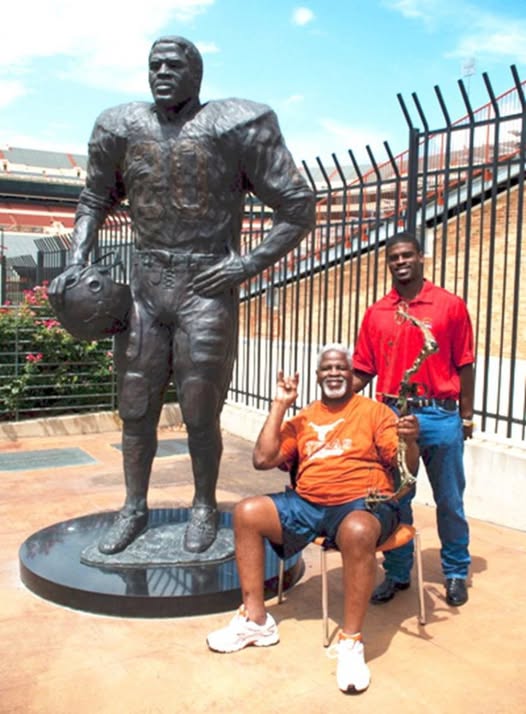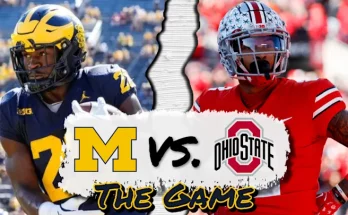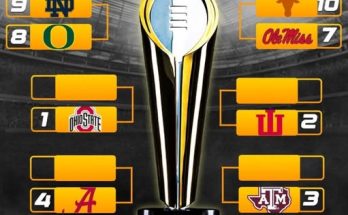In a momentous announcement that has sent waves of excitement through the college football community and beyond, the University of Texas Longhorns have declared their intention to erect a statue honoring one of the most iconic figures in their storied football history: Earl Campbell. This decision is not just a tribute to a remarkable athlete but a celebration of a legacy that transcends generations, embodying the spirit, grit, and excellence that the Longhorn program has always stood for.
Earl Campbell, often revered as one of the greatest running backs in the history of college football and the NFL, carved his name into the annals of sports history with an unmatched combination of power, speed, and determination. His journey from a small-town kid in Tyler, Texas, to a Heisman Trophy winner and eventual NFL Hall of Famer is a testament to his perseverance and extraordinary talent. Now, with this statue, the University of Texas is ensuring that his legacy will inspire countless future Longhorns and fans for decades to come.
Campbell’s football career began to capture national attention in the late 1970s when he donned the burnt orange jersey at the University of Texas. His impact was immediate and profound. Known as “The Tyler Rose” or simply “The Earl,” Campbell’s playing style was characterized by his brutal power and relentless drive, often barreling over defenders with an intensity rarely seen on the gridiron. His freshman year set the tone for what would be a legendary career; he rushed for 866 yards and scored 13 touchdowns, signaling the arrival of a new football force.
By his sophomore and junior years, Campbell was a dominant force in college football. He led the nation in rushing yards both seasons, and his highlight-reel runs became the stuff of legend. However, it was his senior year in 1977 that sealed his place in history. That season, Campbell won the Heisman Trophy, awarded to the most outstanding player in college football, after rushing for 1,744 yards and 19 touchdowns. His performance not only electrified Longhorn fans but also put the University of Texas football program on the national map like never before.
Campbell’s dominance was not limited to the college level. In 1978, he was the first overall pick in the NFL Draft by the Houston Oilers, where he continued to redefine the running back position. His powerful, punishing running style earned him a reputation as one of the toughest players in the league, and he went on to win the NFL Offensive Player of the Year award three times. His professional career, which lasted nine seasons, culminated in his induction into the Pro Football Hall of Fame in 1991, cementing his status as one of the all-time greats.
The decision to erect a statue of Earl Campbell at the University of Texas comes after years of public demand from fans, alumni, and former teammates who believe that his contributions to the school and the sport deserve permanent, physical recognition. The statue will be prominently displayed on campus, near the Darrell K Royal-Texas Memorial Stadium, the heart of Longhorn football tradition. This placement is symbolic, linking Campbell’s legacy directly to the place where he achieved so much and where generations of fans have gathered to witness football greatness.
University officials have expressed profound pride and excitement about the statue project. In a statement released shortly after the announcement, the University of Texas Athletic Director noted, “Earl Campbell is not just a legend in Longhorn football history; he is a symbol of Texas toughness, resilience, and excellence. This statue will forever remind us of what it means to wear the burnt orange and compete with heart and passion. We are honored to celebrate Earl in this way and look forward to unveiling a monument worthy of his enormous legacy.”
The statue itself is expected to be a striking, life-size bronze sculpture depicting Campbell in his classic running stance, muscle-bound and charging forward with the football tucked tightly under his arm. The artist chosen for the project is a renowned sculptor known for creating dynamic and lifelike representations of sports icons. The statue will capture not only Campbell’s physical prowess but also his fierce determination, which defined his playing style.
More than just an artistic tribute, the statue will serve as an educational tool and inspiration for students and athletes alike. It will be accompanied by a dedicated plaza that tells the story of Campbell’s life and career, featuring plaques and multimedia displays highlighting his achievements and the impact he had on Texas football and beyond. This area will become a pilgrimage site for Longhorn fans, a place to remember and reflect on the legacy of one of the greatest to ever wear the Texas uniform.
Earl Campbell’s legacy extends far beyond statistics and trophies. He represents the embodiment of Texas football culture—hard work, resilience, and an unyielding will to succeed. His impact on the sport and on the University of Texas community resonates deeply. Former teammates, coaches, and opponents have often spoken about Campbell’s leadership and character both on and off the field. He was not just a phenomenal athlete but also a mentor and role model who carried himself with humility and grace, inspiring countless young athletes to pursue greatness.
In addition to his football achievements, Campbell has also been an active advocate for health and wellness, particularly concerning the long-term effects of football injuries. His openness about his own battles with health issues related to his playing days has helped raise awareness and inspired conversations about player safety in football. This dimension of his legacy underscores the complexity and humanity of the man behind the legend.
The announcement of the statue has sparked an outpouring of support and enthusiasm from the Longhorn community and sports fans nationwide. Social media has been flooded with tributes, memories, and well-wishes, with many celebrating this overdue recognition of a true icon. Fans have shared favorite moments from Campbell’s career, highlighting his unforgettable runs, his leadership during pivotal games, and the indelible mark he left on Texas football.
As plans for the statue move forward, fundraising efforts have already begun to support the project. The University of Texas is collaborating with alumni groups, boosters, and corporate sponsors to ensure the statue is not only a fitting tribute but also a lasting monument that will stand the test of time. The involvement of the wider Longhorn family underscores how deeply Campbell’s legacy is cherished and how this project unites the community in celebrating its shared history.
The timing of the statue’s unveiling is expected to coincide with a major football event, likely a home game at the Darrell K Royal-Texas Memorial Stadium, where fans will have the opportunity to witness the dedication ceremony. This event will be attended by Earl Campbell himself, along with his family, former teammates, University officials, and a host of dignitaries. It promises to be a historic day for Longhorn football, one that honors the past while inspiring the future.
The erection of Earl Campbell’s statue is more than just a celebration of one player’s career. It is a powerful symbol of the values and traditions that the Texas Longhorns represent. It reminds us all of the impact one individual can have—not only on the field but within a community and a culture. Earl Campbell’s story is a testament to the power of determination, talent, and heart, and the statue will stand as a permanent beacon of these ideals.
In the years to come, young athletes who pass by the statue will be reminded of what it means to give everything for the game, to carry the hopes of a community on their shoulders, and to leave a legacy that lasts well beyond their playing days. Earl Campbell’s statue will be a constant source of inspiration, a tribute to a man who truly embodied the spirit of Texas football.



